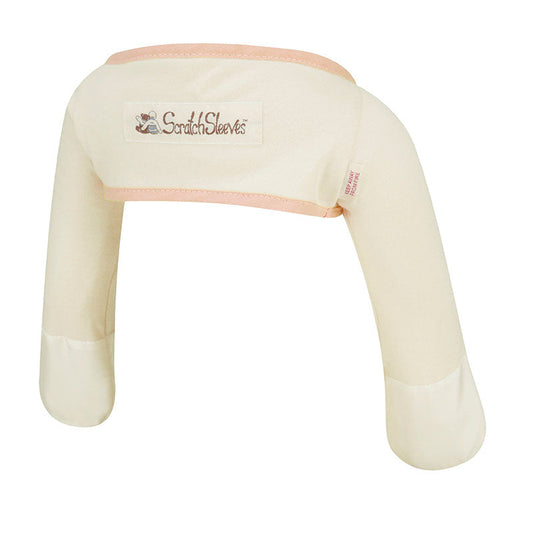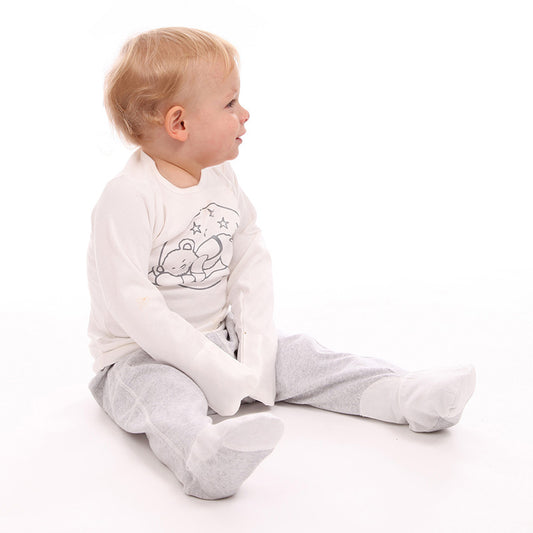Baby Eczema
The main characteristic of eczema in infants is intense itching, which can become unbearable. Itching inevitably leads to scratching, which increases the risk of infection and leads to even more itching and scratching. ScratchSleeves help break the itch-scratch cycle by minimizing scratching damage.
What is baby eczema?
Eczema is an umbrella term that refers to a number of different skin conditions where the skin feels itchy and irritated. The most common type is atopic dermatitis. ‘Dermatitis’ means skin inflammation, and ‘atopic’ means it appears on the body in places which have not been in contact with any allergen. This is what is meant by ‘baby eczema’ or ‘infantile eczema’, although atopic dermatitis can also affect older children and adults.
Baby eczema most commonly shows up in babies before the age of six months – usually around 3-4 months old. It tends to start as a rash on the cheeks, which then spreads to the face and trunk, either in patches or covering the skin. On black or brown skin, the eczema patches may look grey, purple or darker black or brown; on white skin the affected area often appears red. In young babies, eczema flare-ups are typically weepy and red patches (on white skin) or darker patches (on brown and black skin).
As babies get older the patches tend to be more dry and flaky – at which point they may appear more yellow, white or grey. By the time babies have learnt to walk, their eczema will have often shifted to be found in the folds of the knees and elbows. Eczema tends to flare-up and then calm down again. However, the skin is likely to remain dry and flaky between flare-ups.

How common is baby eczema
Although it may feel as though yours is the only baby in the parent and baby group with angry-looking skin, you really are not alone. Up to 20 per cent of children globally have eczema – with a higher prevalence in richer nations1. It usually appears from around 2–6 months and peaks in early childhood. Around 80 per cent of children ‘grow out’ of eczema by the time they are eight2.
But hearing that eczema is really common, or that your baby will probably grow out of it, isn’t much comfort now. The fact is, eczema is a chronic and complex condition that can be very uncomfortable and, at times, distressing for both your child and you. The itching and sleeplessness is more than just disrupting. When parents/carers are already sleep deprived and vulnerable, the anguish this condition causes our little ones can feel debilitating.
The Scratch-Itch Cycle (and its effect on sleep)
These patches of dry or weepy skin are incredibly itchy, especially during a flare-up. This itchiness can cause discomfort, irritability, and worst of all, sleeplessness. Studies have shown that babies with eczema (and their parents) lose an average of two hours sleep a night3.
Babies who have developed the coordination required, will scratch to satisfy the itch (typically around six months)4. Even younger babies will find ways to rub and will quickly learn to rub their itchy faces against any convenient surface, such as your jumper or their sheets. Unfortunately this can quickly lead to damaged skin, which is prone to infection. This damaged skin is even more sensitive and itchy, leading to yet more scratching and more interrupted sleep. ScratchSleeves are designed to break this cycle by minimising the scratching damage.
The importance of diagnosis and treatment
If your child has eczema it’s important to treat it. It won’t go away by itself (at least, not in any timely fashion) – and without appropriate treatment it could get much worse. Not only is eczema vulnerable to infection, ongoing research suggests that proactive early treatment of eczema may help to prevent later food allergies5. It has also been shown that babies with eczema are more prone to food allergies but that early weaning reduces this risk.6
This means that as soon as you suspect eczema, you should contact your doctor to confirm the diagnosis. There is a vast and confusing array of over-the-counter treatments for baby eczema that your doctor can guide you through. It is especially important that your child sees their doctor if the eczema seems to be getting worse, or if they have open cracks or weepiness, as any infection of the damaged skin will need prompt medical attention.
Treatments for baby eczema
The type of treatment that your doctor will prescribe will vary depending on the severity of the eczema. The key medical treatments for eczema are medical-grade moisturisers called emollients, and corticosteroid creams (often just called ‘steroid creams’).
Emollients
Emollients are the first line of therapy for all dry skin conditions. This means they’re the first thing your doctor will prescribe, and they will be the cornerstone of your eczema treatment. Using them as part of a daily routine can soothe, moisturise and protect the skin, helping to reduce the severity of eczema flares-ups, and prevent them occurring in the first place.
Emollients are available as creams and bath additives and there are many different brands available. They are different from moisturisers you might already have in your cupboard because they do not contain any perfumes or any ‘anti-aging’ agents which could aggravate your baby’s skin. Prescription emollients should be low risk for side effects. As every case of eczema is unique, finding an emollient that works well with your baby’s skin will be a case of trial and error. If you don’t see obvious improvements within 3-5 days, you’ll need to try a different emollient.
Be prepared to get through a lot! To give you an idea, you should be applying around 250g of emollient a week on your child’s eczema.
Steroid creams
Emollients should help prevent the eczema from worsening and offer the skin the right conditions to start to heal by itself. However, during a flare-up it’s unlikely that emollients will be enough by themselves. At this point the skin needs extra help to recover, and ideally this should be done quickly to prevent further deterioration or potential infection. Of course, you will also want to relieve the itchy symptoms as fast as possible.
How steroid creams work
Topical corticosteroid creams, also known as ‘steroid creams’, are the first-line of therapy for treating inflammation. This means that this is the first thing that doctors will recommend when the skin needs something extra to bring down a flare-up. Steroids are hormones that are found naturally in the body. Synthetic steroids have powerful anti-inflammatory properties, and they can be applied topically (on the skin) to reduce skin inflammation and irritation. They do this by preventing cells from producing the proteins which cause inflammation7. They do not cure eczema because they are not addressing the underlying cause, but they can provide much-needed relief during flare-ups by soothing the symptoms. This can break the cycle of itching and scratching which often leads to a deterioration of symptoms. They can also give you and your doctor some time to identify the triggers for your baby’s eczema.
How safe are steroid creams
A quick look at online parent forums will quickly show that there is a lot of hesitancy around using steroids. In fact, there is so much anxiety around using steroid cream that it has been given a name – steroid phobia. A study has shown that around 40–60 per cent of parents of children with eczema are worried about using steroid creams, with the hesitancy more pronounced where the eczema is more severe8.
While there are risks associated with steroid cream usage, these are extremely small when the medical instructions are followed. There are also very real risks associated with not treating baby eczema promptly, including the increased risk of serious food allergies. A 2021 umbrella study analysed thirty-eight studies on the effects of topical corticosteroid in the treatment of atopic eczema. It found no evidence of harm when steroid creams are used intermittently to treat flare-ups, or for ‘weekend’ therapy. The National Institute for Clinical Excellence has looked at these studies and concluded that the benefit of using topical steroids in eczema outweighs the potential harm from side effects when used correctly.
What causes Baby Eczema?
Although the exact cause of eczema is not yet fully understood, there is wide acceptance that it is related to an overactive immune system. This excess activity triggers inflammation which in turn damages the skin barrier, leaving it dry, itchy and prone to irritation from allergens in the surrounding environment. The immune system takes time to develop, meaning that babies are more vulnerable to allergens than older children and adults (and that allergy testing isn’t at all accurate in babies and toddlers).
In addition the liver, which clears toxins from the body, doesn’t mature until children are around 2 years old. This means that the body will try to excrete toxins in other ways, including in sweat. When these chemicals are expelled through the pores, they can irritate the skin.
Eczema triggers
Keep an eye out for patterns in your baby’s eczema flare-ups as they may give you a clue to their triggers. Some triggers like laundry detergents (especially those with fragrances and optical brighteners) and family pets are usually fairly easy to spot. However the majority of cases of baby eczema resolve without any obvious causes having been identified.
Cow's milk protein allergy
While cows milk protein allergy (CMPA) is often quoted as being a common trigger for baby eczema, research has found that this isn’t the case. Only 0.5-3% of under 1s have a genuine CPMA allergy9. Unless your baby is also suffering from gastric symptoms, milk is unlikely to be the cause. If you do suspect your baby has CMPA, it’s important to have this diagnosed professionally as nutrition is hugely important for a baby’s development.
In summary
For most babies, eczema will be mild to moderate and will hopefully have minimal impact on daily life, especially when it is not in an active phase. The majority of baby eczema cases resolve naturally by the time children start school2. It’s also worth knowing that eczema that appears before children are 2 years is typically milder than in children where it first appears later. That said, baby eczema is exhausting for both the baby and their parents and, given the possible implications for the development of food allergies, should be taken seriously.
More Information
Visit the ScratchSleeves blog and Facebook page for more information on identifying eczema triggers and living with an eczema baby. Our Childhood Eczema page also has more information.
- NHS choices – more information on diagnosis and treatment
- NSGCCE – Nottingham Support Group for Carers of Children with Eczema: a fantastic resource focused on childhood eczema
- Eczema Outreach Support – Charity founded in 2011 by a mother of an eczema child offering support for the entire family
Our Sources
- Carroll, CL et al. 2005. ‘The Burden of Atopic Dermatitis: Impact on the Patient, Family, and Society’. Pediatric Dermatology, https://pubmed.ncbi.nlm.nih.gov/15916563/
- Kim, JP et al. 2016. ‘Persistence of atopic dermatitis (AD): A systematic review and meta-analysis’. Journal of the American Academy of Dermatology, https://pubmed.ncbi.nlm.nih.gov/27544489/.
- Lusignan, S et al. 2020. ‘The epidemiology of eczema in children and adults in England: A population‐based study using primary care data’. Clinical & Experimental Allergy, https://pubmed.ncbi.nlm.nih.gov/33179341/.
- Elmose, C & Thomsen, SF. 2015. ‘Twin Studies of Atopic Dermatitis: Interpretations and Applications in the Filaggrin Era’. Journal of Allergy, https://pubmed.ncbi.nlm.nih.gov/26448767/.
- Lowe, A et al. 2019. ‘PEBBLES study protocol: a randomised controlled trial to prevent atopic dermatitis, food allergy and sensitisation in infants with a family history of allergic disease using a skin barrier improvement strategy’. BMJ Open, https://pubmed.ncbi.nlm.nih.gov/30867201/.
- Perkin, MR et al. 2016. ‘Enquiring About Tolerance (EAT) study: Feasibility of an early allergenic food introduction regimen’. Journal of Allergy and Clinical Immunology. https://www.ncbi.nlm.nih.gov/pmc/articles/PMC4852987/.
- Steroids (Topical) - American Osteopathic College of Dermatology (AOCD) n.d., www.aocd.org, https://www.aocd.org/page/SteroidsTopical.
- Contento, M et al. 2021. ‘Steroid Phobia: A Review of Prevalence, Risk Factors, and Interventions’. American Journal of Clinical Dermatology, https://pubmed.ncbi.nlm.nih.gov/34287768/.
- Flom, JD & Sicherer, SH. 2019. ‘Epidemiology of Cow’s Milk Allergy’. Nutrients, https://pmc.ncbi.nlm.nih.gov/articles/PMC6566637/.
Quick Buy
-
Cross-over ScratchSleeves
Regular price From €17,95 EURRegular priceUnit price / per -
Flip-mitt bodysuits
Regular price From €19,95 EURRegular priceUnit price / per -
Original Cream
Regular price From €11,95 EURRegular priceUnit price / per -
Sleepy Bear PJ Sets
Regular price From €25,95 EURRegular priceUnit price / per








